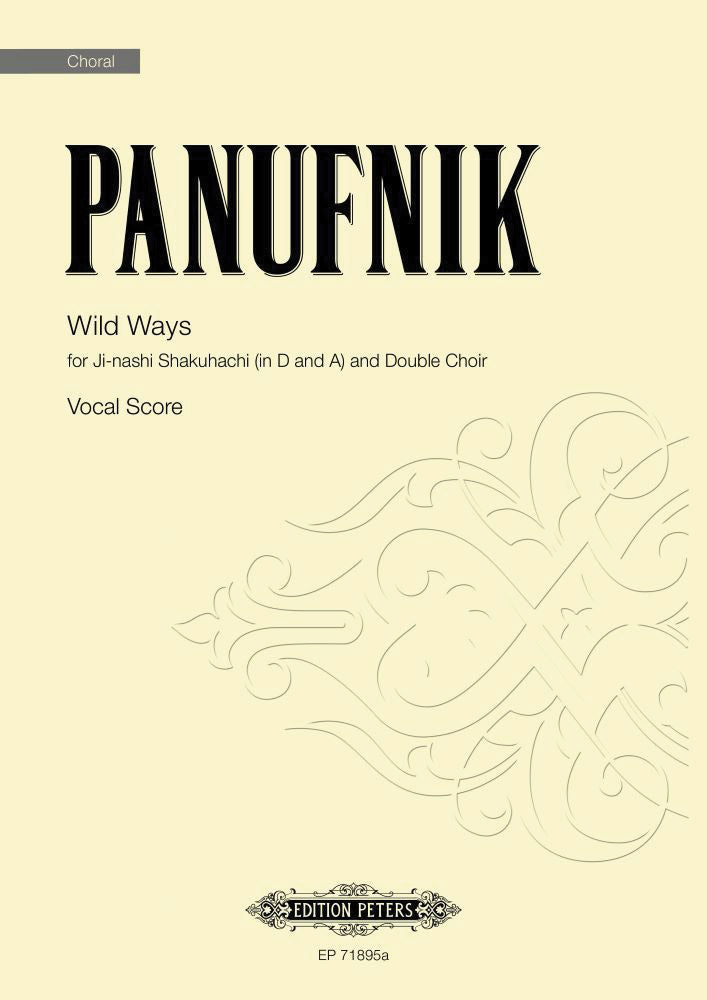Roxanna Panufnik
Panufnik: Wild Ways
- Composer: Roxanna Panufnik (1968-)
- Instrumentation: Mixed Choir, Shakuhachi
- Work: Wild Ways
- Work Languages: English, Japanese
- ISMN:
- Size: 8.7 x 11.8 inches
Description
In 2005, ji-nashi shakuhachi player Kiku Day approached me to write a piece for her, as part of her mission to increase the use of the shakuhachi (Japanese bamboo flute) in Western classical music. When she played to me, its warmth and huskiness seemed so spookily like a human voice that I decided an a cappella double choir setting of words would best complement it. We found a choir – the Nonsuch Singers – brave enough to enter into this project and Kiku found me the wild and wonderful poems of Ikkyu Soyun, a 15th Century Zen master whose timeless words cover the entire gamut of human emotion and are beautifully translated by John Stevenson. The poems are often very short, so each movement is a compilation of two or three of them.
- Crazy Cloud was a name that Ikkyu gave himself when in 1428 he finished his Zen training and went his own "wild way". The movement starts with a boisterous "Noh Theatre"-style acclamation of his nickname in Japanese and the music is "Blown about madly" by shakuhachi and voices alike.
For 2. Love Song, I have used a beautiful and poignant Japanese lullaby called "Edo Komoriuta" (meaning "Lullaby from Edo", the old name for Tokyo) as a backdrop to two of Ikkyu's highly romantic and sensual poems. The lullaby is sung in Japanese and the words depict the loss of a little boy's beloved nursemaid who has gone back to her home. This chimes with how Ikkyu feels at the loss of his true love to another man.
- Autumn Night brings together three of the many poems that Ikkyu wrote which mention this season. During my research into Japanese traditional music I was introduced to mnemonics – a form of aural transmission of music through the natural pitch patterns of various vowel and consonant sounds. These "words" don't actually mean anything but if you try saying the percussion line, Tsu ta pon tsu-ta tsu po-po-pon etc., you will see how the sounds automatically come out as a rough pitch and rhythmic pattern. These are mnemonics taken from a Kabuki dance called "Goro Tokimune". The process is reversed as in the middle verse when the shakuhachi provides the melody whilst the choir recites the words.
There are many people without whom this piece would not exist. I would like to thank Keith Howard for pointing Kiku into my direction, Kiku for bringing me into the wonderful and extraordinary world of the shakuhachi and to David Hughes for his patient teaching of the elements of Japanese traditional music. Thanks also go to Graham Caldbeck and the Nonsuch Singers who have worked incredibly hard to get this project off the ground. We owe a huge debt of gratitude also to both the Sasakawa and PRS Foundations for their financial support of the commission.
Roxanna Panufnik
Publishers use a lot of words to describe what they sell, and we know it can be confusing. We've tried to be as clear as possible to make sure you get exactly what you are looking for. Below are descriptions of the terms that we use to describe the various formats that music often comes in.
Choral Score
A score for vocalists that only contains the vocal lines. The instrumental parts are not there for reference. Generally, cheaper than a vocal score and requires multiple copies for purchase.
Facsimile
Reproductions of the original hand-written scores from the composer.
Full Score
For ensemble music, this indicates that the edition contains all parts on a single system (there are not separate parts for each player). In larger ensembles, this is for the conductor.
Hardcover
Hardbound. Generally either linen-covered or half-leather.
Orchestral Parts
Similar to a wind set, this is a collection of parts. In the case of strings, the numbers listed are the number of copies included, though generally these are available individually (often with minimum quantities required).
Paperback
When publishers offer multiple bindings (e.g. hardcover) or study scores, this is the "standard" version. If you're planning to play the music, this is probably what you want.
Performance / Playing Score
A score of the music containing all parts on one system, intended for players to share. There are not separate parts for each player.
Set of Parts
For ensemble music, this indicates that there are separate individual parts for each player.
Solo Part with Piano Reduction
For solo pieces with orchestra, this is a version that contains a piano reduction of the orchestra parts. For piano pieces, two copies are typically needed for performance.
Study Score
A small (think choral size) copy of the complete score meant for studying, and not playing. They make great add-ons when learning concertos and small chamber works.
Vocal Score
A score prepared for vocalists that includes the piano/organ part or a reduction of the instrumental parts.
Wind Set
For orchestral music, this is a collection of wind and percussion parts. The specific quantities of each instrument are notated.
With Audio
In addition to the printed music, the edition contains recordings of the pieces. This may be an included CD, or access to files on the internet.
With / Without Fingering (Markings)
Some publishers prepare two copies - a pure Urtext edition that includes no fingering (or bowing) suggestions and a lightly edited version that includes a minimal number of editorial markings.






